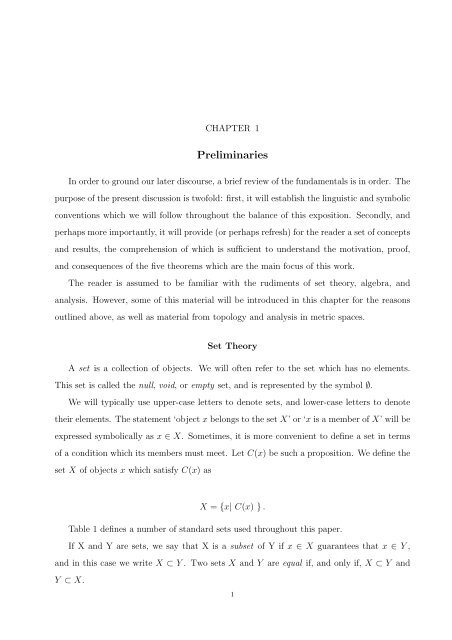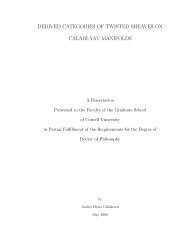FIVE MAJOR RESULTS IN ANALYSIS AND TOPOLOGY Aaron ...
FIVE MAJOR RESULTS IN ANALYSIS AND TOPOLOGY Aaron ...
FIVE MAJOR RESULTS IN ANALYSIS AND TOPOLOGY Aaron ...
You also want an ePaper? Increase the reach of your titles
YUMPU automatically turns print PDFs into web optimized ePapers that Google loves.
CHAPTER 1<br />
Preliminaries<br />
In order to ground our later discourse, a brief review of the fundamentals is in order. The<br />
purpose of the present discussion is twofold: first, it will establish the linguistic and symbolic<br />
conventions which we will follow throughout the balance of this exposition. Secondly, and<br />
perhaps more importantly, it will provide (or perhaps refresh) for the reader a set of concepts<br />
and results, the comprehension of which is sufficient to understand the motivation, proof,<br />
and consequences of the five theorems which are the main focus of this work.<br />
The reader is assumed to be familiar with the rudiments of set theory, algebra, and<br />
analysis. However, some of this material will be introduced in this chapter for the reasons<br />
outlined above, as well as material from topology and analysis in metric spaces.<br />
Set Theory<br />
A set is a collection of objects. We will often refer to the set which has no elements.<br />
This set is called the null, void, or empty set, and is represented by the symbol ∅.<br />
We will typically use upper-case letters to denote sets, and lower-case letters to denote<br />
their elements. The statement ‘object x belongs to the set X’ or ‘x is a member of X’ will be<br />
expressed symbolically as x ∈ X. Sometimes, it is more convenient to define a set in terms<br />
of a condition which its members must meet. Let C(x) be such a proposition. We define the<br />
set X of objects x which satisfy C(x) as<br />
X = {x| C(x) } .<br />
Table 1 defines a number of standard sets used throughout this paper.<br />
If X and Y are sets, we say that X is a subset of Y if x ∈ X guarantees that x ∈ Y ,<br />
and in this case we write X ⊂ Y . Two sets X and Y are equal if, and only if, X ⊂ Y and<br />
Y ⊂ X.<br />
1
















